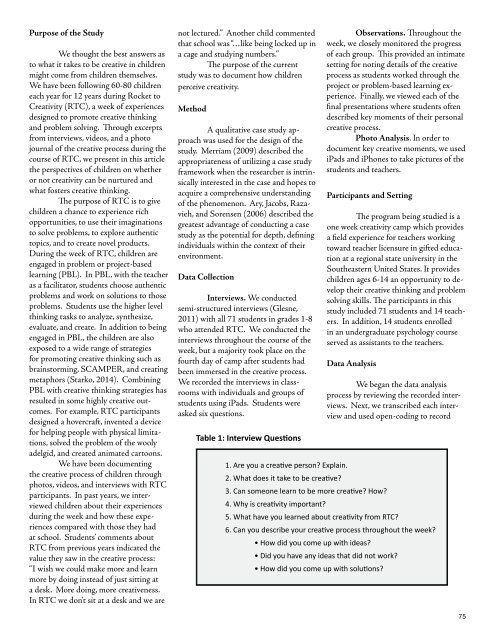Torrance Journal for Applied Creativity
TorranceJournal_V1
TorranceJournal_V1
Create successful ePaper yourself
Turn your PDF publications into a flip-book with our unique Google optimized e-Paper software.
Purpose of the Study<br />
We thought the best answers as<br />
to what it takes to be creative in children<br />
might come from children themselves.<br />
We have been following 60-80 children<br />
each year <strong>for</strong> 12 years during Rocket to<br />
<strong>Creativity</strong> (RTC), a week of experiences<br />
designed to promote creative thinking<br />
and problem solving. Through excerpts<br />
from interviews, videos, and a photo<br />
journal of the creative process during the<br />
course of RTC, we present in this article<br />
the perspectives of children on whether<br />
or not creativity can be nurtured and<br />
what fosters creative thinking.<br />
The purpose of RTC is to give<br />
children a chance to experience rich<br />
opportunities, to use their imaginations<br />
to solve problems, to explore authentic<br />
topics, and to create novel products.<br />
During the week of RTC, children are<br />
engaged in problem or project-based<br />
learning (PBL). In PBL, with the teacher<br />
as a facilitator, students choose authentic<br />
problems and work on solutions to those<br />
problems. Students use the higher level<br />
thinking tasks to analyze, synthesize,<br />
evaluate, and create. In addition to being<br />
engaged in PBL, the children are also<br />
exposed to a wide range of strategies<br />
<strong>for</strong> promoting creative thinking such as<br />
brainstorming, SCAMPER, and creating<br />
metaphors (Starko, 2014). Combining<br />
PBL with creative thinking strategies has<br />
resulted in some highly creative outcomes.<br />
For example, RTC participants<br />
designed a hovercraft, invented a device<br />
<strong>for</strong> helping people with physical limitations,<br />
solved the problem of the wooly<br />
adelgid, and created animated cartoons.<br />
We have been documenting<br />
the creative process of children through<br />
photos, videos, and interviews with RTC<br />
participants. In past years, we interviewed<br />
children about their experiences<br />
during the week and how these experiences<br />
compared with those they had<br />
at school. Students’ comments about<br />
RTC from previous years indicated the<br />
value they saw in the creative process:<br />
“I wish we could make more and learn<br />
more by doing instead of just sitting at<br />
a desk. More doing, more creativeness.<br />
In RTC we don’t sit at a desk and we are<br />
not lectured.” Another child commented<br />
that school was “…like being locked up in<br />
a cage and studying numbers.”<br />
The purpose of the current<br />
study was to document how children<br />
perceive creativity.<br />
Method<br />
A qualitative case study approach<br />
was used <strong>for</strong> the design of the<br />
study. Merriam (2009) described the<br />
appropriateness of utilizing a case study<br />
framework when the researcher is intrinsically<br />
interested in the case and hopes to<br />
acquire a comprehensive understanding<br />
of the phenomenon. Ary, Jacobs, Razavieh,<br />
and Sorensen (2006) described the<br />
greatest advantage of conducting a case<br />
study as the potential <strong>for</strong> depth, defining<br />
individuals within the context of their<br />
environment.<br />
Data Collection<br />
Interviews. We conducted<br />
semi-structured interviews (Glesne,<br />
2011) with all 71 students in grades 1-8<br />
who attended RTC. We conducted the<br />
interviews throughout the course of the<br />
week, but a majority took place on the<br />
fourth day of camp after students had<br />
been immersed in the creative process.<br />
We recorded the interviews in classrooms<br />
with individuals and groups of<br />
students using iPads. Students were<br />
asked six questions.<br />
Table 1: Interview Questions<br />
Observations. Throughout the<br />
week, we closely monitored the progress<br />
of each group. This provided an intimate<br />
setting <strong>for</strong> noting details of the creative<br />
process as students worked through the<br />
project or problem-based learning experience.<br />
Finally, we viewed each of the<br />
final presentations where students often<br />
described key moments of their personal<br />
creative process.<br />
Photo Analysis. In order to<br />
document key creative moments, we used<br />
iPads and iPhones to take pictures of the<br />
students and teachers.<br />
Participants and Setting<br />
The program being studied is a<br />
one week creativity camp which provides<br />
a field experience <strong>for</strong> teachers working<br />
toward teacher licensure in gifted education<br />
at a regional state university in the<br />
Southeastern United States. It provides<br />
children ages 6-14 an opportunity to develop<br />
their creative thinking and problem<br />
solving skills. The participants in this<br />
study included 71 students and 14 teachers.<br />
In addition, 14 students enrolled<br />
in an undergraduate psychology course<br />
served as assistants to the teachers.<br />
Data Analysis<br />
We began the data analysis<br />
process by reviewing the recorded interviews.<br />
Next, we transcribed each interview<br />
and used open-coding to record<br />
1. Are you a creative person? Explain.<br />
2. What does it take to be creative?<br />
3. Can someone learn to be more creative? How?<br />
4. Why is creativity important?<br />
5. What have you learned about creativity from RTC?<br />
6. Can you describe your creative process throughout the week?<br />
• How did you come up with ideas?<br />
• Did you have any ideas that did not work?<br />
• How did you come up with solutions?<br />
75


